Exercises (3202)
Extension and flexion of the legs with raising and lowering of the upper body while standing (Romanian deadlift) ► romanian deadlift
Power
Individual work
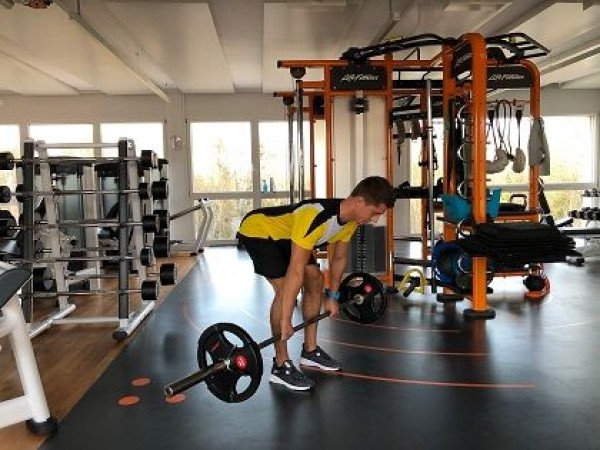

Standing upright with your feet hip-width apart, grip the barbell shoulder-width apart with your arms straight (hanging). Move the weight along your legs towards the floor, bending your knees only slightly. Then straighten your legs again and raise your upper body back to the starting position.
Starting position:
- Stand upright with hips hip-width apart
- Grasp the barbell with hands shoulder-width apart, arms hanging
Finishing position:
- Upper body tilted forwards
- Buttocks pushed back (hip hinge)
- Straight back
Attention:
The back remains straight throughout the entire exercise, i.e. the barbell should only be moved as far towards the floor as the correct posture allows (if possible, the weight can also be briefly lowered to the floor).
Extension and flexion of the legs with raising and lowering of the upper body while standing (Romanian deadlift) ► romanian deadlift
Power
Individual work
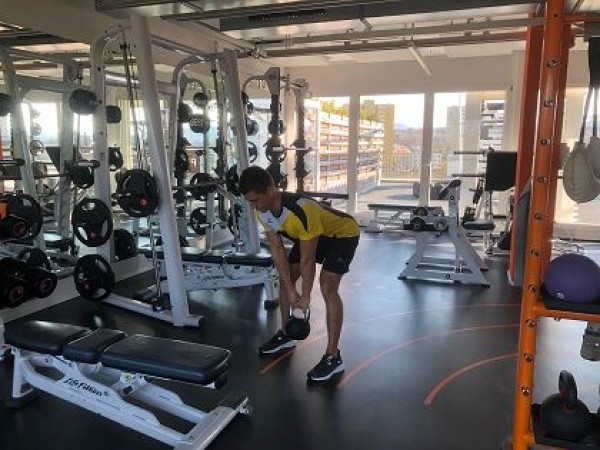

Stand upright with your feet hip-width apart and grasp the weight with both outstretched (hanging) arms. Move the weight between your legs towards the floor (if possible, move the weight along your legs towards the floor), bending your knees only slightly. Then straighten your legs again and raise your upper body back to the starting position.
Starting position:
- Stand upright with hips hip-width apart
- Hands grasp the weight shoulder-width apart, arms hanging
Finishing position:
- Upper body tilted forwards
- Buttocks pushed backwards (hip hinge)
- Straight back stretched out
Attention:
The back remains straight throughout the entire exercise, i.e. only lift the weight as far towards the floor as the correct posture allows (if possible, the weight can also be briefly lowered to the floor).
1 kettlebell
Extension and flexion of the legs with raising and lowering of the upper body while standing ► romanian deadlift
Power
Individual work


Stand upright with your feet shoulder-width apart, hold an object (e.g. a rucksack or sandbag) in front of your body with your arms hanging straight out in front of you, bend your upper body forwards with your back straight and bend your legs at slightly different times so that the object can be brought to the floor in front of your feet. Stretch your legs and straighten your upper body to return to the starting position (Romanian deadlift).
Attention:
Keep your back straight (tense your core).
Lighten:
Less/no weight.
Harden:
Hold the weight in front of your chest, on your neck or hold it up; more weight.
Variation:
Keep your legs straight and only tilt your upper body forwards.
1 sandbag/fighting rucksack
1 helmet ► Make the exercise easier
1 weight disc/tyre (PUCH) ► Make the exercise more difficult (additional weight)
Extension and flexion of the legs with upward movement of the arms while standing (left)
Power
Individual work
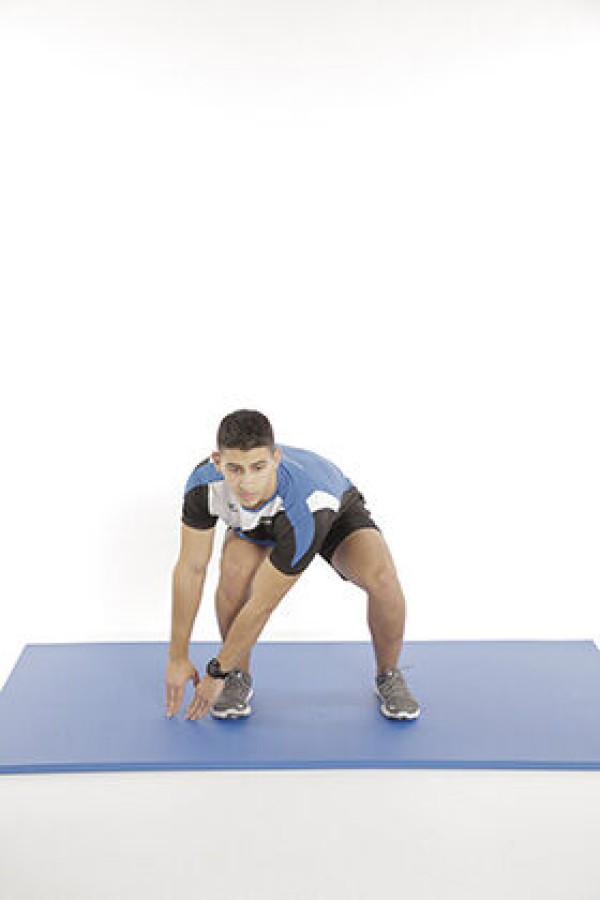
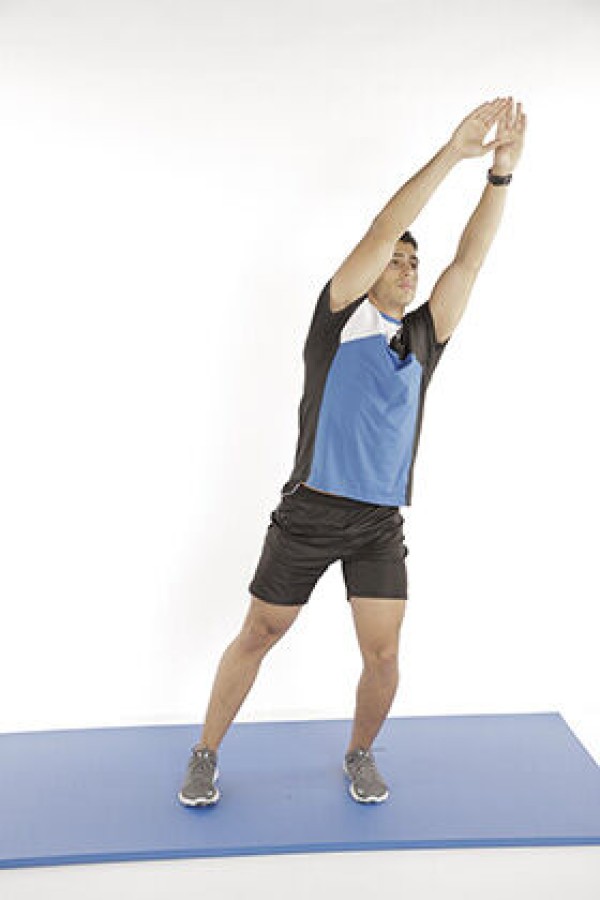
Squat, arms outstretched together next to the left standing leg, stretch your legs and at the same time bring your outstretched arms diagonally upwards to the right above your head, bend your legs to return to the starting position.
Attention:
Keep your knees behind your toes in the squat.
Lighten:
Bend your knees less (greater angle).
Harden:
Bend your knees more (smaller angle); hold additional weight on your arms or in your hands.
2 weight cuffs/weight balls/dumbbells/1 (medicine) ball/weight disc ► Make the exercise more difficult (additional weight)
Extension and flexion of the legs with upward movement of the arms while standing (left)
Power
Individual work


Squat, hold the pistol with outstretched arms in both hands next to the left standing leg, stretch your legs and at the same time bring your outstretched arms (pistol) diagonally upwards to the right above your head, bend your legs to return to the starting position.
Attention:
Keep your knees behind your toes in the squat position.
Lighten:
Bend your knees less (larger angle).
Harden:
Bend your knees more (smaller angle).
1 pistol (neutralised)
Extension and flexion of the legs with upward movement of the arms while standing (right)
Power
Individual work
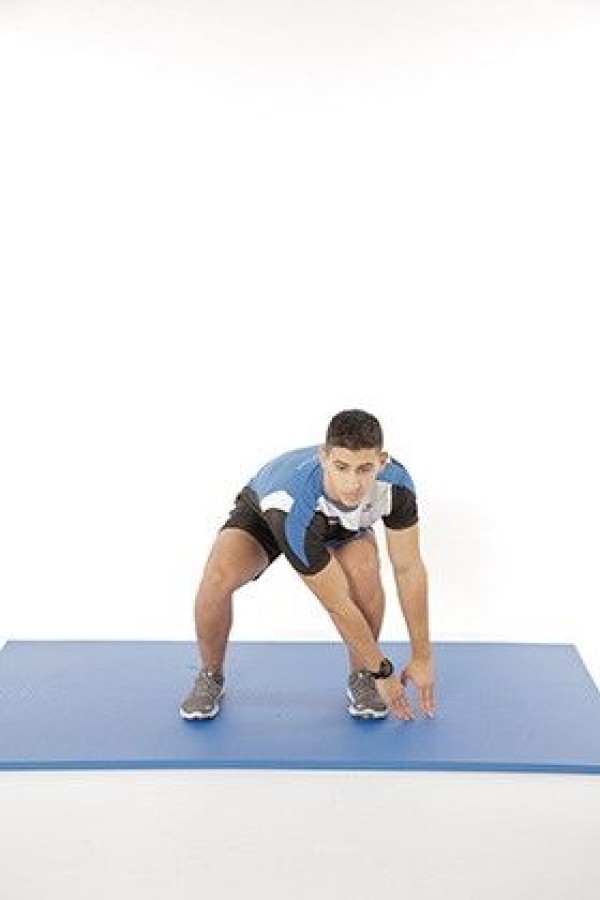
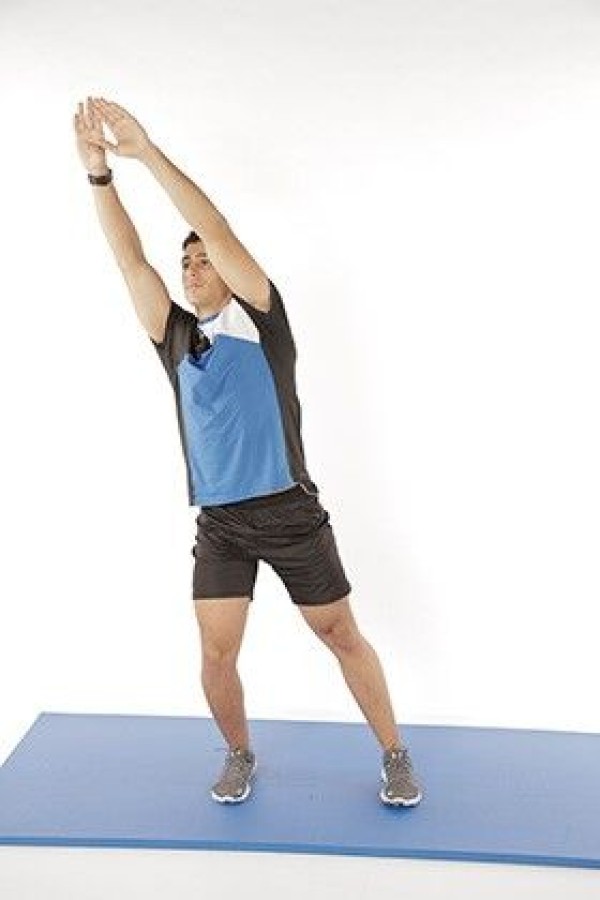
Squat, arms outstretched together next to the right standing leg, stretch your legs and at the same time bring your outstretched arms diagonally upwards to the left over your head, bend your legs to return to the starting position.
Attention:
Keep your knees behind your toes in the squat position.
Lighten:
Bend your knees less (greater angle).
Harden:
Bend your knees more (smaller angle); hold additional weight on your arms or in your hands.
2 weight cuffs/weight balls/dumbbells/1 (medicine) ball/weight disc ► Make the exercise more difficult (additional weight)
Extension and flexion of the legs and arms while standing (repositioning + pushing) ► clean + jerk
Power
Individual work

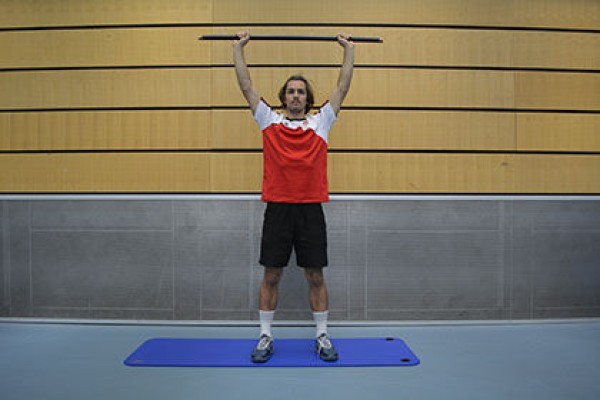

Squat down and grasp the barbell about shoulder-width apart (position the barbell over your midfoot), arms straight. Pull the bar upwards and catch the weight on your shoulders with your knees slightly bent (mainly pushing out of your legs - elbows pointing forwards). Then stretch your legs and work your upper body to bring the weight up to the high hold position.
Starting position:
- Squat, shoulder-width apart
- Upper body slightly bent forwards
- Arms shoulder-width apart and stretched
Finishing position:
- Stand upright
- Hold the bar overhead with arms almost outstretched
Attention:
This exercise is only for advanced users and requires a high level of knowledge, mobility and stability. Always make sure your back is straight (torso tension).
1 Langhantel
Extension and flexion of the legs and arms while standing (repositioning) ► clean
Power
Individual work


Squat down and grasp the barbell about shoulder-width apart (position the barbell over your midfoot), arms straight. Pull the bar upwards and catch the weight on your shoulders with your knees slightly bent (push it out of your legs).
Starting position:
- Squat, shoulder-width apart
- Upper body slightly bent forwards
- Arms shoulder-width apart and stretched
Finishing position:
- Stand upright
- Bar rests on your shoulders (elbows pointing forwards)
Attention:
This exercise is only for advanced users and requires a high level of knowledge, mobility and stability. Always keep your back straight (torso tension). In the final position, the weight of the bar should be on your shoulders and not in your hands.
1 Langhantel
Extension and flexion of the legs and arms while standing (repositioning) ► clean
Power
Individual work

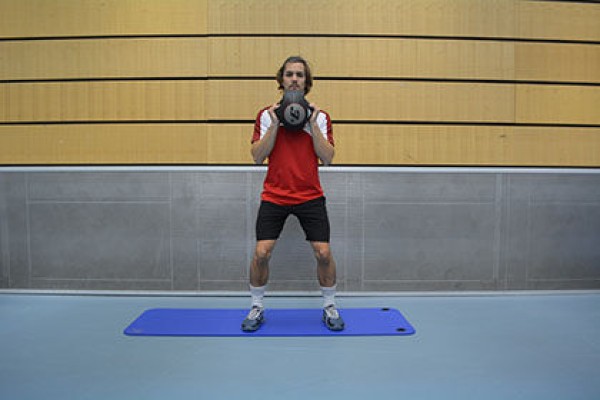
Squat down and grasp the weight (kettlebell) between your legs with your arms straight. Pull the weight upwards and catch it at chest height with slightly bent knees and bent arms (push from the legs - elbows pointing downwards, forearms parallel and facing forwards).
Starting position:
- Squat, standing shoulder-width apart
- Upper body slightly bent forwards
- Arms shoulder-width apart and stretched, grasp weight between legs
Finishing position:
- Stand upright
- Hold the weight in front of your chest (arms bent, elbows pointing downwards, forearms parallel and facing forwards)
Attention:
This exercise is for advanced users only and requires a high level of knowledge, mobility and stability. Always keep your back straight (torso tension).
1 kettlebell
Alternating extension and flexion of the legs and arms while standing ► clean + jerk
Power
Individual work
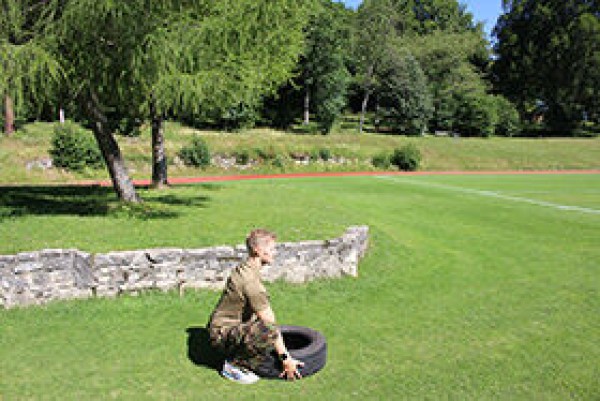

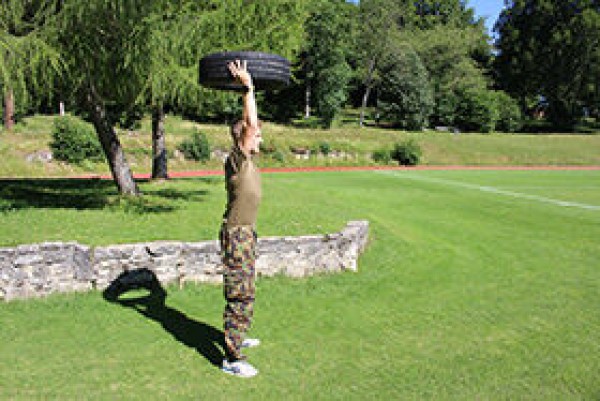
Grab the object lying on the floor (e.g. rucksack) with both hands and lift it above your head, place the object back down in front of your feet and start the exercise again.
Attention:
Keep your back straight, lift the weight from your legs and distribute it over your entire foot.
Lighten:
Less weight/load.
Harden:
More weight/greater load.
1 combat rucksack/weight plate
1-2 PET bottles (1.5 litres)/1 helmet ► Make the exercise easier
1 sandbag/tyre (PUCH) ► Make the exercise more difficult (additional weight)
Extension and flexion of the legs as well as moving an arm upwards while standing (upward hook) ► uppercut
Power
Individual work
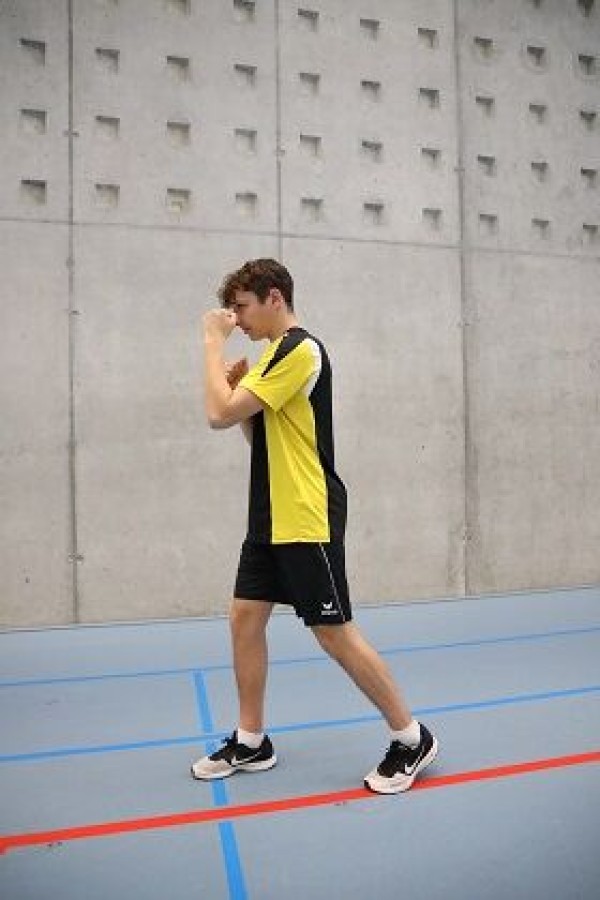
A distinction is made between the left-handed and right-handed stance. Right-handers take the left stance (left foot in front), while left-handers take the right stance (right foot in front). The left-hand stance: The left foot is placed one step forwards from a parallel stance approximately shoulder-width apart so that the right hand is behind. The right hand corresponds to the striking hand, the left hand to the leading hand. The distance between the two feet is approximately one shoulder width, with the feet on a diagonal to each other. The front foot stands on the entire sole, the heel of the back foot is raised. Both feet point forwards and the weight is evenly distributed over both legs. The front shoulder is turned slightly inwards. The whole body is slightly crouched, the knees are slightly bent and soft. The striking hand is placed in front of the chin and rests against the body. The lead hand is in front at eye level. The fists point outwards with the back. The arms are in front of the body and the elbows point downwards so that the arms cover the body. Alternately or in a free rhythm, the punching or leading hand is lowered to belly button height and brought back up to eye level in front of the face (upward hook, palm facing the face). The power of the punch is derived from the body action and not from the arm. The body action consists of stretching the leg and moving the hip forwards. The heel of the front foot turns outwards. When the fist comes up, turn away from the body into the punch.
Attention:
Always keep your arms up (chin or eye level).
Lighten:
Smaller movements/lower intensity of the punching movement (less leg extension/rotation).
Harden:
Hold additional weight on your arms or in your hands.
2 weight cuffs/weight balls/dumbbells ► Make the exercise more difficult (additional weight)
Extension and flexion of the legs and upward movement of the arm while standing (snatch) (left) ► snatch
Power
Individual work


Squat down and grab the weight (dumbbell or kettlebell) with one hand (left) between your legs, arm extended. By extending your legs and moving your arm upwards, pull the weight overhead (especially pushing it out of your legs) and stabilise the position by holding the weight up.
Starting position:
- Squat, hip-width apart
- Upper body slightly bent forwards
- Grasp the weight between the legs, arm extended
Finishing position:
- Stand upright
- Hold the weight overhead, arm almost extended in a high hold
Attention:
This exercise is only for advanced users and requires a high level of knowledge, mobility and stability. Always make sure your back is straight (torso tension).
1 dumbbell/kettlebell
Extension and flexion of the legs and upward movement of the arm while standing (snatch) (right) ► snatch
Power
Individual work
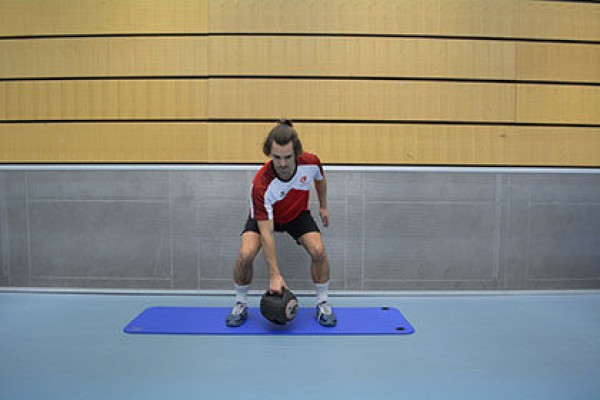

Squat down and grab the weight (dumbbell or kettlebell) with one hand (right) between your legs, arm extended. By extending your legs and moving your arm upwards, pull the weight overhead (especially pushing it out of your legs) and stabilise the position by holding the weight up.
Starting position:
- Squat, hip-width apart
- Upper body slightly bent forwards
- Grasp the weight between the legs, arm extended
Finishing position:
- Stand upright
- Hold the weight overhead, arm almost extended in a high hold
Attention:
This exercise is only for advanced users and requires a high level of knowledge, mobility and stability. Always make sure your back is straight (torso tension).
1 dumbbell/kettlebell
Extension and flexion of the legs and moving one arm upwards while standing (snatch) and alternating push-ups ► push up & snatch
Power
Individual work
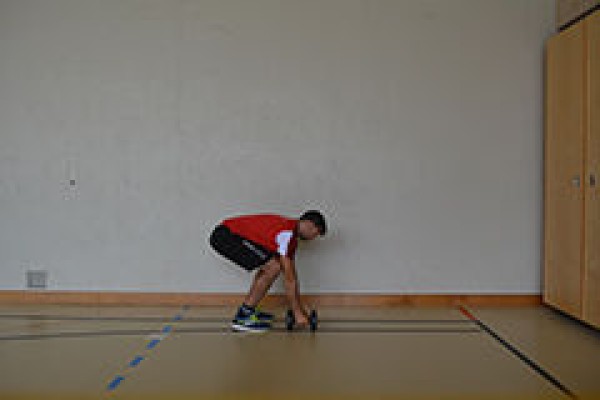
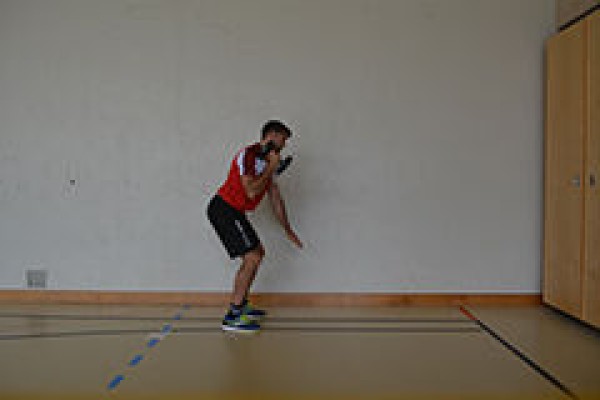






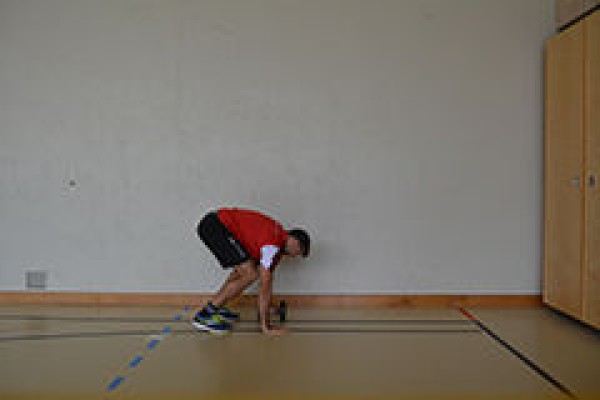





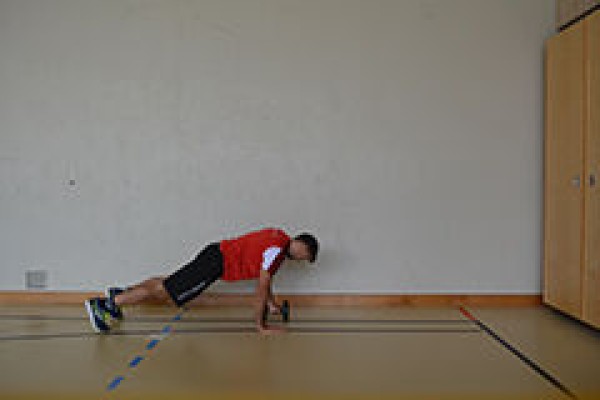

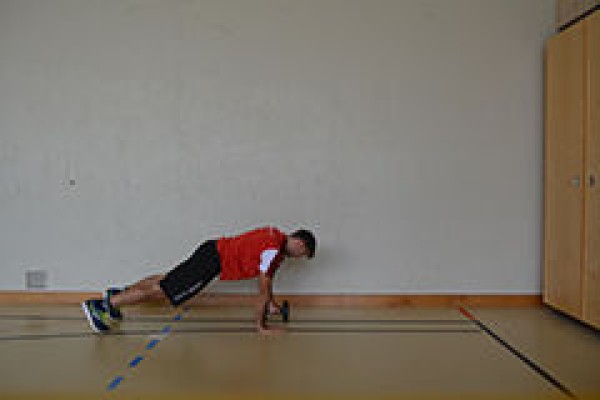

In the squat position, grasp the weight (dumbbell or kettlebell) with one hand between the legs, arm extended, pull the weight overhead by stretching the legs and moving the arm upwards (mainly pushing it out of the legs), then lower the weight to the floor again in the reverse sequence of movements. In the squat position, continue to hold the weight with one hand and bring the other hand to the floor so that the upper body is supported by the hands. Jump backwards with both legs into the push-up position, bend and stretch your arms (lower and raise your upper body). In the push-up position, take the weight in the other hand (move your arms, roll the dumbbell to the side or transfer the weight to the other hand) to start the exercise from the beginning.
Attention:
This exercise is only for advanced users and requires a high level of knowledge, mobility and stability. Always keep your back straight (torso tension). No hollow back in the push-up position (tense your stomach).
Lighten:
Less weight; place your knees on the floor during the push-up (feet held high) or lower your upper body less (arms barely bent).
Harden:
More weight; additional weight.
1 dumbbell/kettlebell
Extension and flexion of the feet while seated ► calf press
Power
Individual work


The foot position is chosen so that only the balls of the feet rest on the footplate. In a slow and controlled movement, the weight is pushed away from the body with the tips of the feet and returned to the starting position. The movement takes place in the ankle joint.
Starting position:
- Feet bent at hip-width, only the balls of the feet on the footplate
- Knees slightly bent
Finishing position:
- Extend foot (plantar flexion)
- Lower back remains firmly in place.
- Ankle, knee joint and hip are in one line
Attention:
Utilise the entire range of motion (extend all the way down).
Variant:
Perform the exercise on one leg to avoid any muscular imbalance.
1 weight tower/machine ► leg press
Extension and flexion of the ankles while standing ► calf raise
Power
Individual work
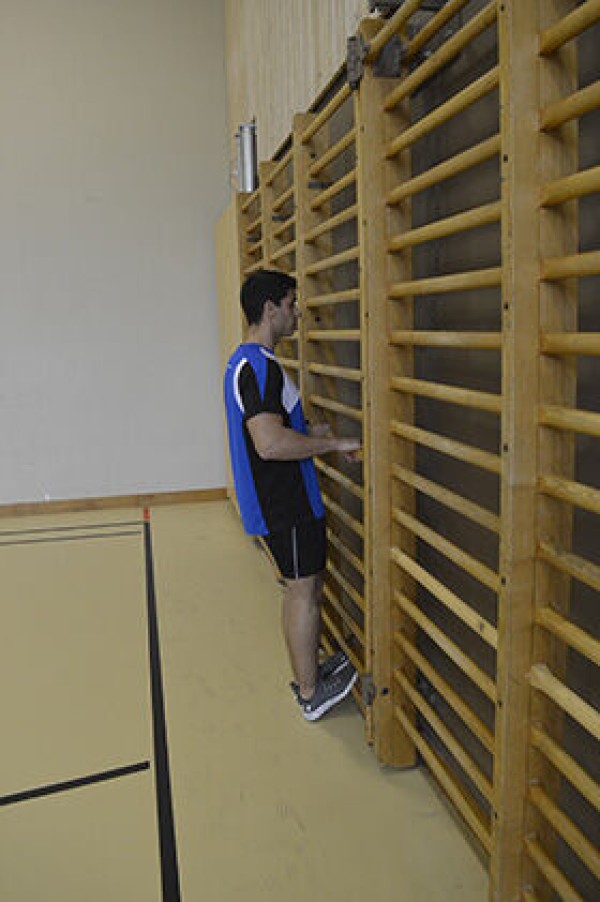

Stand shoulder-width apart with your toes on one of the lower rungs of the wall bars, hold on to one of the upper rungs with your hands (chest height), raise and lower your feet on the wall bars (push your upper body up).
Attention:
Arms are not supportive (possibly grasp the rung with an underhand grip).
Lighten:
Arms as support.
Harden:
Additional weight (hold with one hand on the shoulders).
1 wall bars
1 weight vest/sandbag ► to make the exercise more difficult (additional weight)
Extension and flexion of the ankles while standing ► calf raise
Power
Individual work
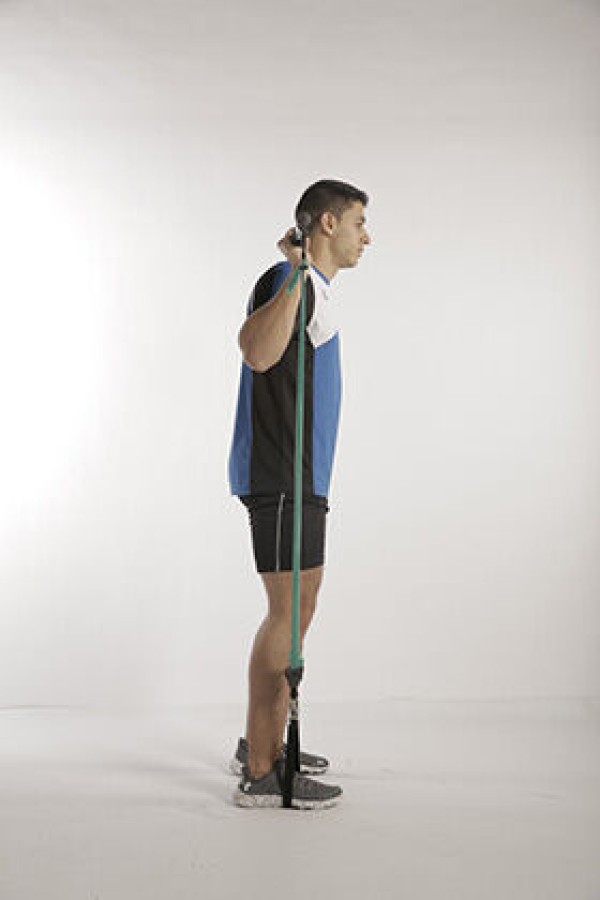
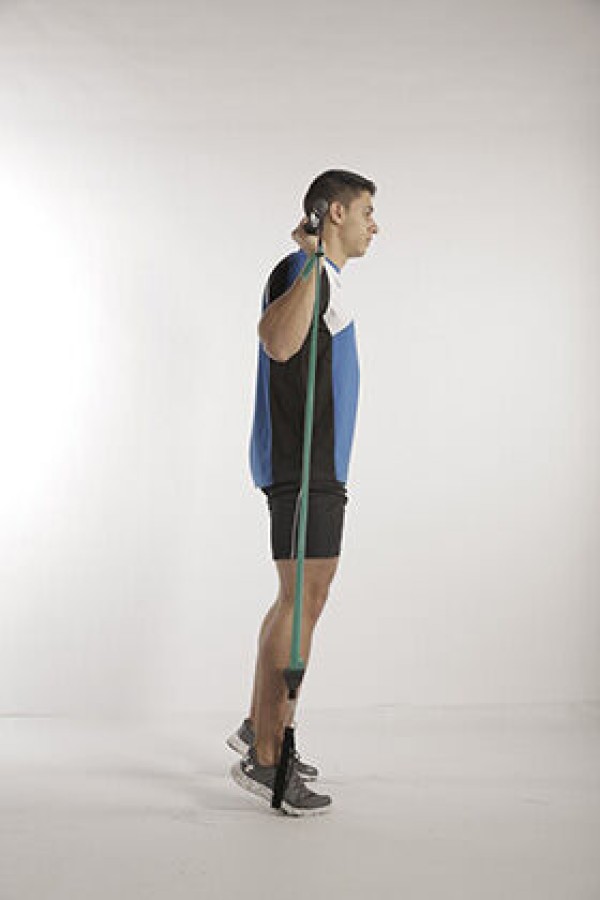
Stand upright shoulder-width apart, feet in the loops, holding the gymnastics pole on your shoulders behind your head, rise up onto your toes against the resistance of the elastic bands (tiptoe stand) and return to the starting position.
Attention:
Perform the movement slowly and in a controlled manner.
Lighten:
Choose less strong elastic bands; roll up the elastic bands less.
Harden:
Choose stronger elastic bands; roll up the elastic bands more.
Variation:
Combine the exercise with squats for additional strain on the thigh and gluteal muscles.
1 gymnastic bar with elasticated straps
Extension and flexion of the ankles while standing ► calf raise
Power
Individual work


Stand with the balls of both feet hip-width apart on a small elevation (e.g. balance board). The barbell is leant on the back of your neck behind your head. Push/lift your feet up as far as possible to the tiptoe position and lower them back down to the starting position in a controlled manner.
Starting position:
- Stand with the balls of your feet on a raised surface
- Heels hanging (below the surface/tips of your toes)
- Upper body upright, torso tensed
Finishing position:
- Feet maximally extended (standing on tiptoe)
- Torso remains tensed
Attention:
The barbell exercise should only be performed once you have practised your balance and technique. If you lose your balance at the wrong moment, you risk injury.
Variant: The exercise can also be performed on one leg (without the barbell) (which doubles the training time).
1 barbell
1 raised base
Extension and flexion of the hips and raising and lowering of the arms while standing ► hip swing
Power
Individual work



Stand upright, feet hip-width apart, knees slightly bent. With your back straight and your knees still slightly bent, grasp the weight in front of you. As you pick up the weight, swing it backwards through your spread legs until your forearms lightly touch your hips and then push your forearms forwards with your hips. It is important that the weight moves upwards with the swing of the pelvis (perform the movement slightly at the beginning/swing the ball forwards just a little, and as soon as you have memorised the movement, swing the weight a little further upwards).
Attention:
A hunched back is a bad posture. The weight moves upwards through the hip movement and not by raising the arms (loose shoulders, curl the shoulder girdle). The knees do not move forwards and the feet remain on the floor for the necessary stability (no standing on tiptoe).
Lighten:
Less weight.
Harden:
Move the weight up to the height of the face. More weight.
Variant:
Hold the weight with one hand (train both sides = organisation requires twice the time).
1 dumbbell/kettlebell
1 weight disc ► Variation of the exercise (one-handed)
Extension and flexion of the hips and raising and lowering of the arms while standing ► hip swing
Power
Individual work
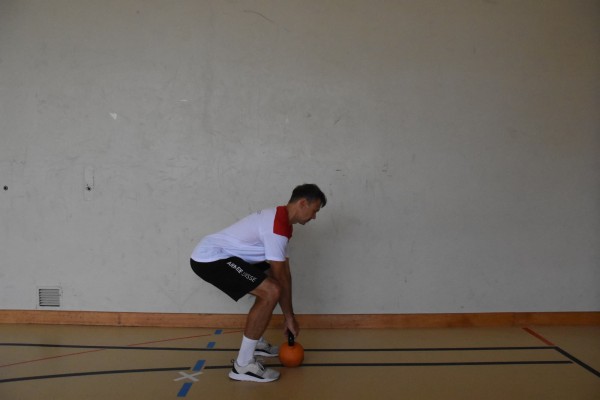
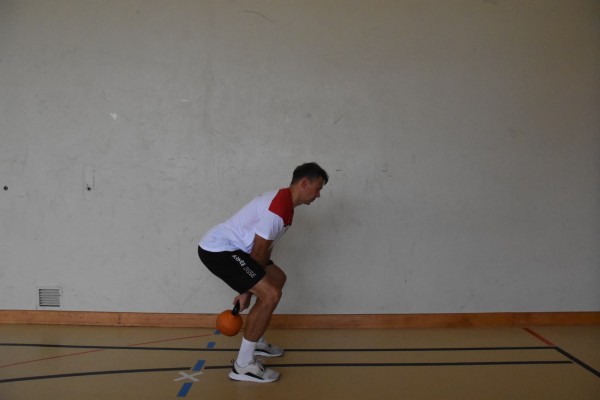
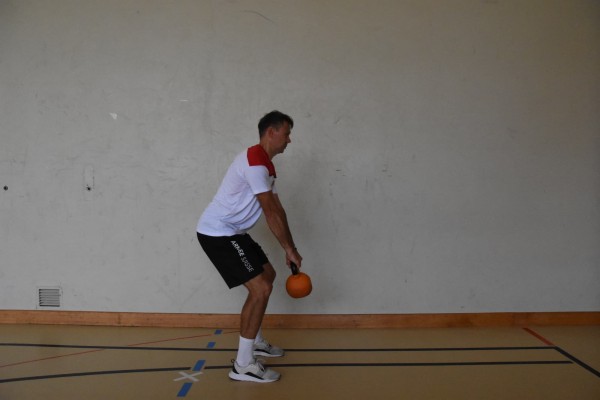

Stand upright, feet hip-width apart, knees slightly bent. With your back straight and your knees still slightly bent, grasp the weight in front of you. As you pick up the weight, swing it backwards through your spread legs until your forearms lightly touch your hips and then push your forearms forwards with your hips. It is important that the weight is brought upwards with the swing of the pelvis (perform the movement slightly at the beginning/swing the object forwards just a little, and then swing the weight a little further upwards as soon as you have memorised the movement sequence).
Attention:
A hunched back is a bad posture. The weight moves upwards through the hip movement and not by raising the arms (loose shoulders, curl the shoulder girdle). The knees do not move forwards and the feet remain on the floor for the necessary stability (no standing on tiptoe).
Lighten:
Less weight.
Harden:
Move the weight up to the height of the face. More weight.
Variant:
Hold the weight with one hand (train both sides = organisation requires twice the time).
1 sandbag/fighting backpack/kettlebell
Extension and flexion of the forearms in supine position ► skull crusher
Power
Individual work


Lying on your back on the flat bench, place your feet flat on the floor. Hold the barbell with an overhand grip at shoulder width and with your arms stretched out above your chest (front hold). Now bend your elbows to lower your forearms so that the barbell is lowered just above your forehead. Then straighten your arms and move the weight back to the starting position in a controlled manner.
Starting position:
- Lie on your back on the flat bench, feet flat on the floor
- Arms (almost) stretched across your chest (in front of you)
- Hold the barbell shoulder-width apart in the overhand grip
Finishing position:
- Arms bent, barbell lowered just above your forehead
Attention:
Movement only comes from the elbows, position of the elbows remains stable (keep the distance between the arms unchanged, do not let the elbows break out to the side), whereby the upper arms do not (hardly) move.
1 barbell
1 flat bench
Extension and flexion of the arm (shoulder press) from the lunge (left) ► lunge & shoulder press
Power
Individual work

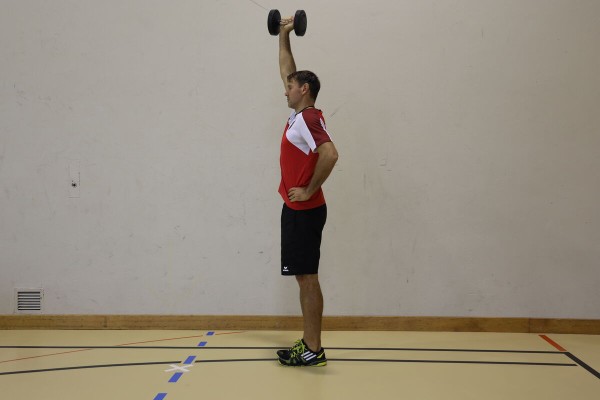
Lunge, the front (left) leg is placed on the floor with a right angle at the knee joint, the back (right) leg is placed on the floor on tiptoe only, with the thigh and lower leg also at approximately a 90 degree angle. One arm (left) is supported on the hip, the right arm is bent and holding the weight in the hand (dumbbell or kettlebell) so that the weight is next to the head at ear level. From this position, straighten the front leg and simultaneously push the back leg off the floor to reach a standing position in one fluid movement. While performing the movement, push the bent arm with the weight in your hand vertically upwards (hold the arm up). The other arm remains supported on the hip. Then bring the right leg back and bend the left leg to return to the starting position in a lunge. The playing arm is also bent back to the starting position.
Attention:
Always keep the front knee behind the tip of the foot and centred over the foot, upper body upright and abdomen tensed.
Lighten:
Lower your upper body less (greater angle in the knees); without additional weight (dumbbell or kettlebell).
Harden:
More weight; additional weight (on the back foot).
1 dumbbell/kettlebell
1 weight sleeve ► Make the exercise more difficult (additional weight)
Extension and flexion of the arm (shoulder press) from the lunge (right) ► lunge & shoulder press
Power
Individual work
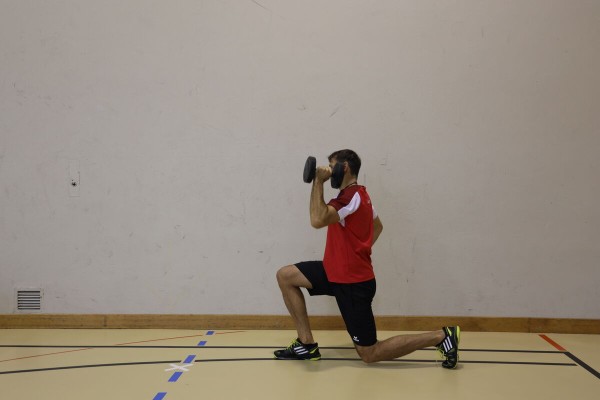
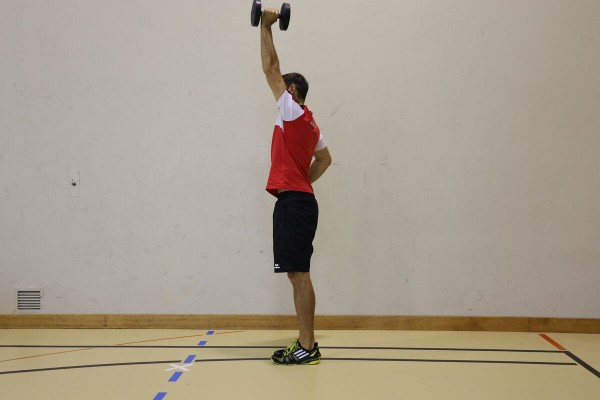
Lunge, the front (right) leg is placed on the floor with a right angle at the knee joint, the rear (left) leg is placed on the floor on tiptoe only, with the thigh and lower leg also at approximately a 90 degree angle. One arm (right) is supported on the hip, the left arm is bent and holding the weight in the hand (dumbbell or kettlebell) so that the weight is next to the head at ear level. From this position, straighten the front leg and simultaneously push the back leg off the floor to reach a standing position in one fluid movement. While performing the movement, push the bent arm with the weight in your hand vertically upwards (hold the arm up). The other arm remains supported on the hip. Then bring the left leg back and bend the right leg to return to the starting position in a lunge. The playing arm is also bent back to the starting position.
Attention:
Always keep the front knee behind the tip of the foot and centred over the foot, upper body upright and abdomen tensed.
Lighten:
Lower your upper body less (greater angle in the knees); without additional weight (dumbbell or kettlebell).
Harden:
More weight; additional weight (on the back foot).
1 dumbbell/kettlebell
1 weight sleeve ► Make the exercise more difficult (additional weight)
Extension and flexion of the arm / move the arm upwards (left) ► Shoulder press
Power
Individual work
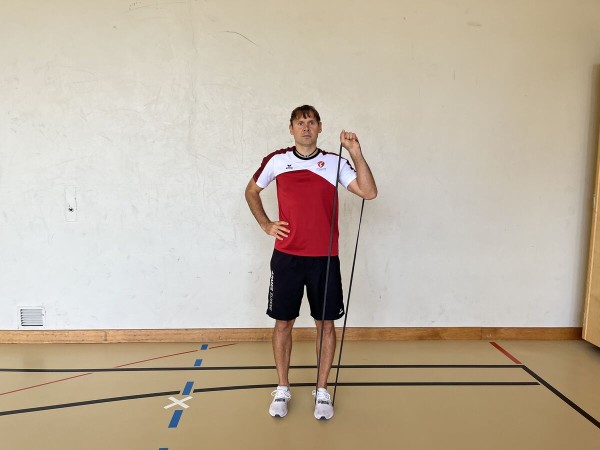

Stand upright, shoulder-width apart, left foot centred on the elastic band, left hand grasping the band at chest height with an overhand grip (back of hand pointing towards the face), elbow of the bent arm pointing downwards, arm next to the ear stretched straight upwards and bent back to the starting position.
Attention:
Do not arch your back (tighten your stomach).
Lighten:
Choose a rubber band with less resistance.
Harden:
Choose a rubber band with more resistance.
Variation:
Stepping position with the left front foot on the centre of the band.
1 elasticated rubber band
Extension and flexion of the arm / move the arm upwards (right) ► Shoulder press
Power
Individual work
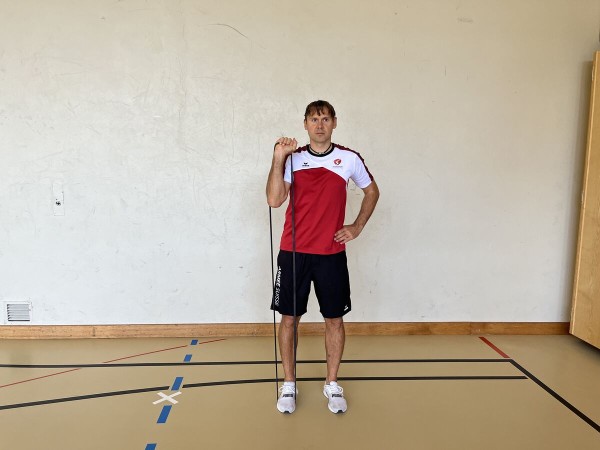
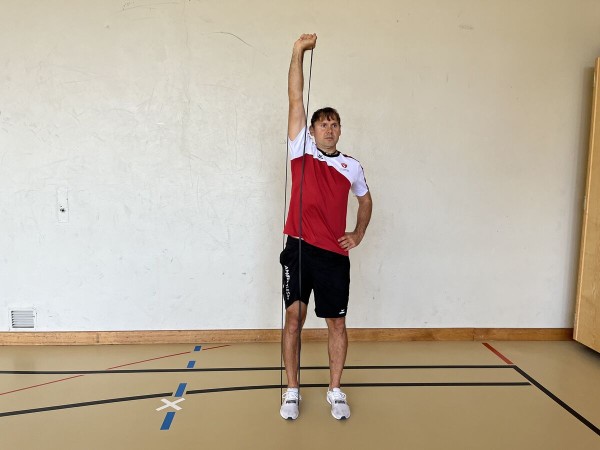
Stand upright, shoulder-width apart, right foot centred on the elastic band, right hand grasping the band at chest height with an overhand grip (back of hand pointing towards the face), elbow of bent arm pointing downwards, arm next to the ear extended straight upwards and bent back into the starting position.
Attention:
Do not arch your back (tighten your stomach).
Lighten:
Choose a rubber band with less resistance.
Harden:
Choose a rubber band with more resistance.
Variant:
Stepping position with the right front foot on the centre of the band.
1 elasticated rubber band